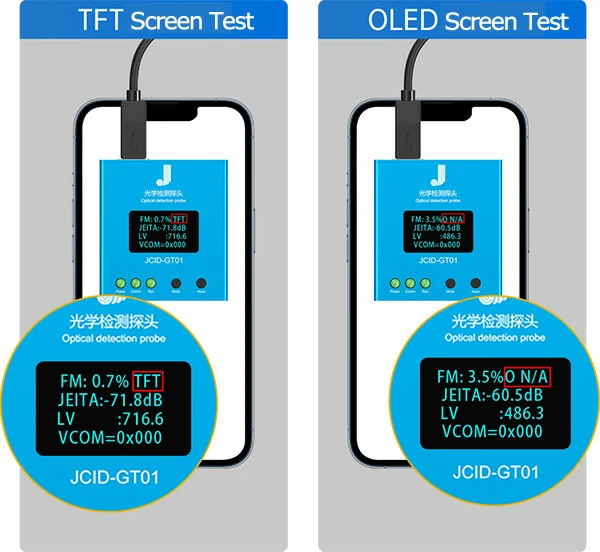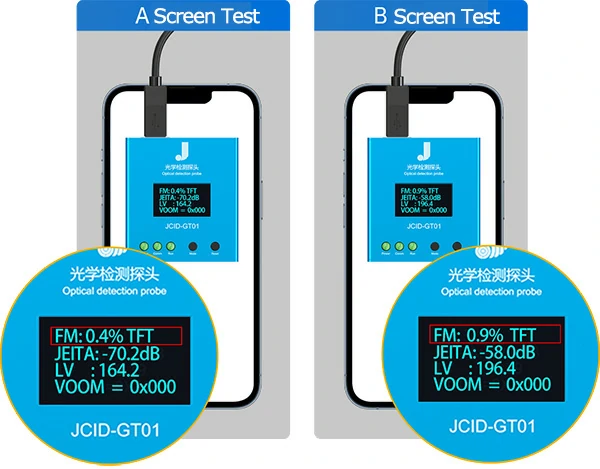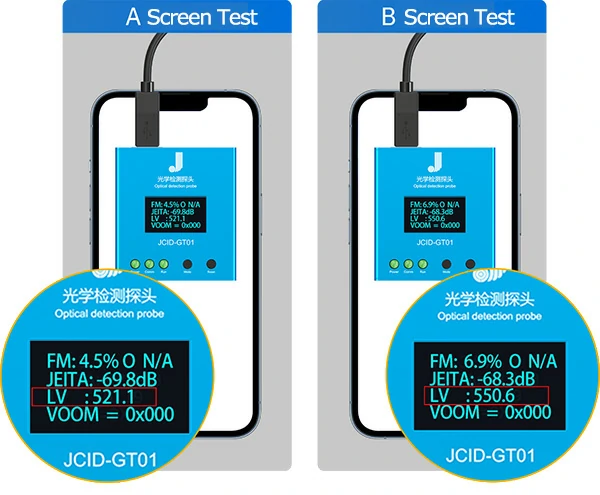
In today's digital age, smartphones are indispensable, and the quality of the screen directly impacts user experience. A premium screen offers high clarity, delivering crisp and lifelike images. With excellent color reproduction, it accurately portrays details, while responsive touch ensures smooth and precise operation. Strong durability minimizes scratches and wear, extending the device's lifespan. In the mobile repair industry, prioritizing screen quality is crucial as it influences visual experience, device performance, and longevity.
Why Should We Use the JCID GT01 Optical Screen Inspection Probe for Screen Detection?
Reason 1: Distinguish between TFT screen and OLED screen
TFT Screen: Requires backlight to display images, relatively lower cost.
OLED Screen: It is self-luminous and does not require backlight. Compared to TFT, OLED screen are thinner, have lower power consumption, better luminosity, and finer color representation. They are commonly used in high-end electronic products.
Comparison Result: OLED screen quality is higher than TFT screen
Difficulty in Differentiation: It is difficult for non-professionals to distinguish
Using GT01: Automatically identifies and displays the screen type.

Reason 2: Test TFT screen flicker value (Flicker value)
Definition: Screen flicker value generally has two algorithms, FMA method and Jeita method. The screen flicker value will affect the display effect of the screen and easily hurt the eyes, so it is generally required that the lower flicker value, the better screen .
Difficulty in Distinguishing: Screen flickers often occurs at frequencies that are difficult to detect with the naked eye.
Effects: Severe flickering can cause eye fatigue, vision loss, dizziness and other discomforts.
Test purpose: Through comparative testing, the quality differences of different screens can be judged
Using GT01: can quickly detect the Flicker value of the screen, support offline operation, and connect to V1S PRO for operation

|
A Screen |
VS. |
B Screen |
|
Flicker Value: 0.4% |
< |
Flicker Value: 0.9% |
|
The larger the flicker value, the more harmful it is to the eyes. Therefore, the lower the flicker value, the better. From this, we can conclude: |
||
|
A Screen Quality |
Better Than |
B Screen Quality |
Reason 3: Check the LV value of the screen
LV value: Also known as luminance value, it is used to evaluate whether the brightness of the screen can meet industry or self-defined standards under the same conditions.
Test purpose: By testing, the quality of the screen can be judged.

|
A Screen |
VS. |
B Screen |
|
LV Value: 521.1 |
< |
LV Value:550.6 |
|
Original Screen LV Value-510, the LV value of A screen is closer to the original, so we can conclude: |
||
|
A Screen Quality |
Better Than |
B Screen Quality |
Remote upgrade available, unlock more features soon...
1. Supports offline testing.
2. Supports connection to V1S Pro for testing.
3. Detect the screen flicker value.
4. Detect the screen LV value.
5. Distinguish between TFT screen and OLED screen
 WhatsApp
WhatsApp